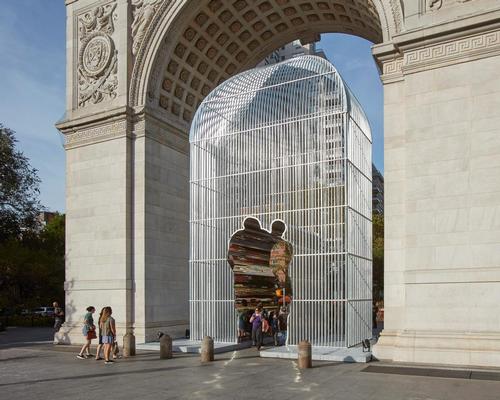08 Dec 2017
Public creativity crucial for cities, argues Urban Art Projects founder after Ai Weiwei collaboration in New York
BY Kim Megson

One of the team responsible for realising Ai Weiwei’s huge ‘security fence’
installations across New York has told CLADglobal the popularity of the project demonstrates why cities and developers would be “mad” not to commission creativity.
Dan Tobin, the founder of international creative design and delivery studio Urban Art Projects (UAP), said that boundary-pushing art “sparks conversations, activates communities, creates memories, celebrates different cultures, drives tourism and enables micro and macro economies”.
UAP collaborated with the Chinese artist on Good Fences Make Good Neighbors in New York – which opened in October 2017 and runs until February next year.
Partly backed by a successful crowdfunding campaign, the citywide public art exhibition is inspired by the international migration crisis and includes large-scale sculptures that depict the security fence as a social and artistic symbol.
Over 300 site-specific, freestanding works have been installed, including highly visible ones at the Washington Square Arch in Greenwich Village, the Unisphere at Flushing Meadows-Corona Park in Queens, and at the Doris C. Freedman Plaza at Central Park.
The latter places an abstract, golden cage in a space where it is juxtaposed against one of the most visited urban public parks in the US.
UAP worked with multidisciplinary studio AECOM Tishman, architecture firm FXFOWLE, engineer Thornton Tomasetti and street furniture company JCDecaux to bring Ai’s larger visions to life.
“Delivering such a project in a compressed timeframe and on budget for one of the world’s most influential artists was a daunting task,” said Tobin. “Ai Weiwei and the Public Art Fund, who backed the project, had very high expectations and we also had to take into account the high-profile nature of the sites.
“There were certainly challenges. With teams scattered across three continents – the artist and his team based in Berlin, UAP’s design and project management team in New York and our fabrication team in Shanghai – late night and early morning video conferences were often a daily occurrence.”
He added that while “serious engineering” was required to create the structures and secure installation approvals from the city authorities, the result was worth the effort.
“Ai Weiwei was extremely pleased by how true to his creative intent the built forms are, which is immensely satisfying for us,” he said. “But being on-site post-installation and watching and listening to people as they talked about and explored the works has been the definite highlight for me.”
Despite receiving criticism from some local groups, including the Washington Square Association, for politicising pre-existing architecture and art, Ai’s installations have received critical acclaim and been a hit with the public.
Tobin told CLADglobal he would like to see more encouragement of public art to replicate the success of Good Fences Make Good Neighbors.
“Whether it’s London’s Fourth Plinth, Christo’s Floating Piers on Lake Iseo in Italy, or indeed Ai Weiwei’s work, public commissions do it all,” he said.
UAP are currently collaborating with a number of other artists in the US, including Erwin Redl, who has just created a network of suspended lighted orbs in Madison Square Park, and French duo Ronan and Erwan Bouroullec, who are installing a series of sculptural shade structures in the streets of Miami.
Close Window